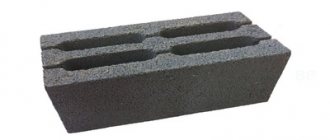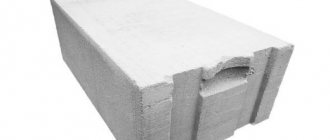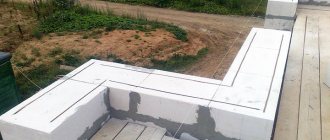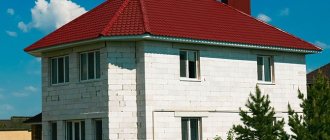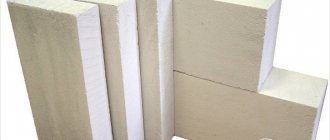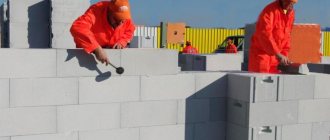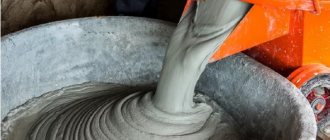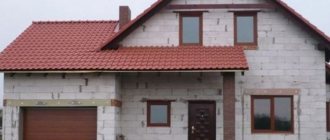Thermal conductivity of gas silicate blocks
When choosing a material, a big role is played by how they are able to distribute heat, so the thermal conductivity of gas silicate blocks is of great importance. Recently, when constructing one-story buildings, I increasingly prefer gas silicate blocks in comparison with wood, brick, etc. Due to their porous structure, the blocks have a low thermal conductivity. The level of thermal conductivity is directly dependent on the level of density of gas silicate blocks and is usually indicated by appropriate markings.
Markings of gas silicate blocks
As mentioned above, depending on the density brand, the thermal conductivity of gas silicate blocks also changes.
- D300, D400 - The least durable grades, due to high porosity, whose thermal conductivity is the lowest. Such blocks are used exclusively as additional thermal insulation of installed walls;
- D500, D600 - These brands have an optimal level of thermal insulation. As a rule, they have medium strength. Designed mainly for construction between rooms and installation of internal walls;
- D700 - They have the highest thermal insulation rates and are used for installing load-bearing walls in low buildings.
What is gas silicate concrete
Gas silicate belongs to the group of cellular (foamed) concrete (SN 277-80) and is a wall block intended for the construction of enclosing structures (except for foundations).
Made from a mixture of:
- binder (Portland cement according to GOST 10178-76, calcium lime (according to GOST 9179-77);
- silicate or siliceous filler (quartz sand, fly ash, etc.);
- technical water;
- gas-forming additives (aluminum powder and others).
This composition ensures an active chemical reaction, which results in the formation of a large amount of hydrogen. It foams the concrete mass and after curing, a highly porous material with high thermal insulation properties is obtained.
Wall aerated blocks are produced in two ways:
- usual, that is, the composition hardens in shape under natural conditions and dries for 2-4 weeks. The finished product is inexpensive, but not very durable. The shrinkage coefficient is 2-4 times higher than that of the factory one;
- autoclave (GOST 31360-2007). The blocks are subjected to heat and moisture treatment (steaming) in special units - autoclaves. The steam pressure is maintained at 9 bar, temperature – up to +175 °C.
Thermal conductivity of blocks depending on humidity
Thermal conductivity of grades in dry form:
- D300 0.072 W/m;
- D400 0.094 W/m;
- D500 0.12 W/m;
- D600 0.14 W/m;
- D700 0.175 W/m.
Thermal conductivity at 4% humidity:
- D300 0.088 W/m;
- D400 0.177 W/m;
- D500 0.141 W/m;
- D600 0.16 W/m;
- D700 0.192 W/m.
With a high level of accumulation, gas silicate blocks are not used in buildings with high levels of humidity, without prior treatment with a layer of waterproofing.
What you need to know about aerated concrete when choosing it for construction
When purchasing gas silicate blocks, it would be useful to remember some of their features, namely:
- frost resistance - the greater and more often the temperature changes occur, the more the material wears out and becomes brittle. The importance of the parameter is directly related to the climatic zone in which the building is located - with high humidity, its service life is greatly reduced;
- moisture resistance and vapor permeability - silicate material cannot boast of hydrophobicity, which is largely due to the addition of lime during production. The more cement is used according to the preparation recipe, the less moisture will be absorbed by the blocks;
- shrinkage is the ability of blocks to noticeably reduce their size, which is observed immediately after the production of the material or its installation, so there is no need to rush during construction.
Useful properties of gas silicate blocks
- Non-flammability. The downside is that the fire resistance limit is not very high - only up to 400? C. This means that walls cannot be made from this material in production workshops that involve the use of high temperatures. When installing a stove in a house, it is necessary to provide a thermally insulating wall made of brick or clay.
- Environmental friendliness. Gas silicate blocks are made from components that can pose a danger only directly during production - lime, cement and aluminum powder. After the solution hardens, all substances are in a bound state, therefore they are safe for builders and future residents.
The only point at which it is advisable to control the purchased blocks is their radiation background. It can be easily checked using a household dosimeter.
The low toxicity of gas silicate blocks deserves a rating of 4 points. A slight underestimation is due to the large amount of dust that is formed during the gating of walls and other types of finishing.
Dimensions of silicate blocks
The silicate block can have different sizes, which depends on the purpose of the product. For example, the width of wall blocks varies from 120 to 248 mm. As for the length and height, they remain the same for all sizes and are equal to 250 and 238 mm, respectively.
Interior blocks have the same length and height, which are 500 and 249 mm, respectively. The width can vary from 70 to 115 mm. Inter-apartment partitions have fixed parameters, they are equal to 498 x 115 x 249 mm. These dimensions are specified in the regulatory documents GOST 23421-79, GOST 379-95, SNiP 3.03.01-87.
Thermal conductivity coefficient of a gas block: what is it and how to calculate?
Aerated concrete blocks are used for the construction of single- and multi-story buildings.
This material is popular in the construction of residential buildings, sheds, bathhouses, garages and more. There are several types of gas blocks. They all differ in a number of indicators, the basic of which is thermal conductivity. Read about what this value is, what it depends on and how it affects the choice of building material.
What does the concept mean?
Thermal conductivity coefficient is the ability of aerated concrete to transfer thermal energy. That is, the higher this indicator, the faster the blocks will release the accumulated heat into the environment.
As a result, the room cools down at a high rate.
It is important to know the thermal conductivity of a building material, since this parameter determines how comfortable it will be to live indoors during the cold season.
This indicator directly affects the amount that owners of aerated concrete houses will spend on heating costs.
What does this indicator depend on?
The thermal conductivity of gas blocks depends on the porosity of the material. The more voids there are in the block, the faster it will release the accumulated heat .
The density of aerated concrete and its thermal conductivity are interrelated concepts. The density of the blocks is indicated by the marking D300 – D1200. The lower the number, the higher its thermal conductivity.
There is also a dependence of thermal conductivity on ambient humidity and indoor humidity. It increases with increasing air humidity. Therefore, it is so important to take into account the climatic zone in which the building will be erected . Find out separately about what the moisture resistance of a gas block is and whether this material is afraid of moisture.
What happens: comparative characteristics
Depending on the density of the aerated concrete block and the percentage of humidity, the thermal conductivity of the building material will differ. The comparative characteristics are given in the table, where T is thermal conductivity.
| Block Density | T at 0% humidity | T at 4% humidity | T at 5% humidity |
| D300 | 0.072 | 0.084 | 0.088 |
| D400 | 0.096 | 0.113 | 0.117 |
| D500 | 0.112 | 0.141 | 0.147 |
| D600 | 0.141 | 0.160 | 0.183 |
From the table it becomes clear that the denser the blocks, the higher their thermal conductivity. It also increases with increasing humidity levels.
Requirements for aerated concrete blocks of different markings
When choosing aerated concrete blocks for construction, you need to consider what kind of wall will be built from it . There are certain requirements for the building material used for external, internal, load-bearing and non-load-bearing walls.
For external and internal walls
For the external walls of one-story buildings, aerated concrete with a marking of at least D500 is used.
Internal non-load-bearing walls can be lined with gas blocks marked D300 and D400. It is also permissible to use them for thermal insulation of buildings made of other materials.
However, due to the increased fragility of such blocks, they are not suitable for the construction of load-bearing walls. Requirements for thermal conductivity of gas blocks for different types of walls:
- D300 and D400 - used as a material for thermal insulation of external walls.
- D500 – D900 – suitable for the construction of external and load-bearing internal walls.
- D1000 – D1200 – used for the construction of load-bearing walls in multi-storey buildings.
The requirements for gas blocks depend on what kind of building will be built from it. If the material is purchased for the construction of a garage, unheated shed, workshop or summer house for temporary stay, then they do not need high-quality thermal insulation.
You only need to pay attention to the strength of the blocks. In this case, the material marked D400 - D500 is considered the most suitable. It is suitable for construction in most regions of the Russian Federation.
For non-load-bearing partitions
Non-load-bearing partitions can be erected from any aerated concrete . However, most builders advise choosing blocks marked D300 and D400. They are strong enough to withstand the load placed on non-load-bearing walls and allow you to retain heat inside the room.
In addition, such material costs less than its dense counterpart. Therefore, such a purchase will be more profitable from an economic point of view and will not affect the quality of construction. All the main characteristics of the partition gas block and the rules for its selection are described in detail here.
How to calculate the required thermal conductivity?
Walls made of aerated blocks must be wide enough to retain heat in the room. If you make them too thin, the building will cool down. To avoid such a problem, it is necessary to perform the calculations correctly. SNIP rules, which are available for each region of the country, help prevent mistakes. There are 3 types of humidity conditions :
- Wet – 1.
- Normal – 2.
- Dry – 3.
A special map will help you understand what region a person lives in:
The higher the air humidity level in the region where you live, the thicker and denser the walls should be , since dampness promotes rapid heat loss.
Without taking into account the thermal conductivity coefficient of an aerated concrete block, it is impossible to correctly determine the thickness of the wall of a building under construction.
- T is the thickness of the wall.
- Rreg is the required heat transfer resistance for different cities of the Russian Federation.
- λ is the thermal conductivity coefficient for the gas block (depending on its density).
This formula is very easy to use. Practical example :
Rreg for Moscow is 3.28. λ for gas block brand D500, 5% humidity – 0.14. Total: T= 3.28 x 0.147 = 0.48.
This means that the thickness of the wall in Moscow, taking into account the thermal conductivity of the selected aerated block, should be at least 48 cm.
As an example, the minimum thickness of walls made of D500 aerated blocks for different cities in Russia is given:
- Moscow – 35 cm.
- Novosibirsk – 45 cm.
- Yakutsk – 65 cm.
The higher the humidity levels in the region and the colder it is, the thicker the walls should be.
Otherwise, it will not be possible to achieve high-quality thermal insulation. Inexperienced builders often build walls that are too thin, following the recommendations of gas block manufacturers, who do not take into account many factors such as cold bridges, climatic features of the region, etc.
Experts on this issue come to a consensus: a wall made of aerated concrete should not be thinner than 350 mm .
Consequences of the wrong choice
If a block with a thermal conductivity higher than recommended was chosen for the construction of the building, you will have to face problems such as:
- The walls will quickly give off heat, which will significantly increase heating costs in winter.
- The room will be damp, condensation will begin to accumulate on the walls, which will lead to mold.
- Damp walls freeze quickly. The water collected inside increases in size and destroys the gas block. As a result, the walls will begin to crumble, microcracks will appear in them, which in the future will merge into large defects, and the building will collapse.
In general, living in a cold house is uncomfortable. An improper indoor climate leads to the development of chronic diseases .
Conclusion
Aerated concrete blocks have good thermal conductivity, but only if the building material is chosen correctly. To do this, it is necessary to pay attention to the strength level of aerated concrete, as well as the climatic conditions in which the work is carried out. Be sure to take into account air humidity and the type of wall being built.
Prices
What is the price? The cost of the presented material depends on its size. If you decide to purchase a block of 600x100x300 mm, then you will have to pay 95 rubles per piece. When purchasing a product 600x200x300, the cost will be 180 rubles per piece.
Gas silicate blocks are a very popular material. It is actively used in the construction of houses, load-bearing walls and even for insulation. The characteristic advantages of this material are its strength, durability and thermal conductivity. When choosing a gas silicate block, pay attention to the density and size.
Environmentally friendly and easy to use
According to users, the success of the described material is due to the fact that it has unique properties, because silicate products consist almost entirely of sand, which makes up 92% of the total mass. It is always available and is responsible for environmental safety, which reduces the cost of products.
Buyers like that silicate tongue-and-groove blocks have special grooves and ridges that allow masonry to be done without filling the vertical joints with glue. The installation of such products is carried out using an adhesive seam, the thickness of which is five millimeters or less.
Why choose silicate block
The products are characterized by increased sound insulation characteristics, fire safety, and the ability to reduce costs and material consumption for the structure, because the walls can be made thin. The silicate block represents a new solution for the profitable construction of private houses.
This material in Europe today is one of the most popular in individual housing construction. The assembly of tongue-and-groove blocks means the reliability of the building, as well as ease of installation, because the elements are assembled together according to the Lego principle.
Reviews of tongue-and-groove silicate blocks
The silicate wall block, according to consumers, provides excellent noise protection. For example, the insulation index for an interior partition is 48 dB. This figure drops to 47 dB when it comes to inter-apartment partitions.
Consumers also like the high quality of these products, because the blocks are made using new German presses, which ensures excellent product geometry. The front surface is ideal, which is why there is no need to carry out expensive finishing work. Silicate blocks, reviews of which should help you make the right choice, are thin. Buyers like that this saves interior space.
Laying can be done quite quickly and simply. This comparison is especially relevant when taking into account traditional bricks, which increase the labor intensity of the process and the consumption of mortar. Thus, instead of six bricks, you will need only one tongue-and-groove silicate block, the characteristics of which you must study before purchasing the product. It is also impossible not to note the insignificant weight of such products, which is 40% less than brick.
Installation can be carried out using “Block” glue, and the thickness of the seam will be from 1.5 to 2 mm. With these parameters, glue consumption will vary from 1.5 to 2 kg/m2. To lay a square meter you will need only six blocks. Adjusting the elements is quite simple, because you can use grooves for this. Buyers also like the cost-effectiveness. One square meter of partition made from such blocks will cost less than using other materials.
Dimensions
What are the length, width and thickness? Gas silicate products can be manufactured in various sizes, it all depends on the manufacturer. Most often, such products can be found in the following dimensions:
- 600x200x300 mm,
- 600x100x300 mm,
- 500x200x300 mm,
- 250x400x600 mm,
- 250x250x600 mm.
Foam block or gas block, which is better for building a house, can be found out in this article.
But as for the mass of the block, everything is determined taking into account the density.

